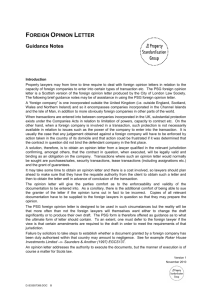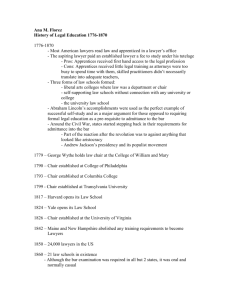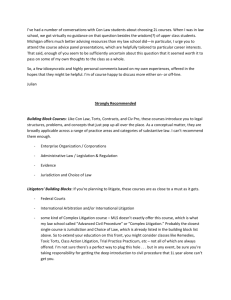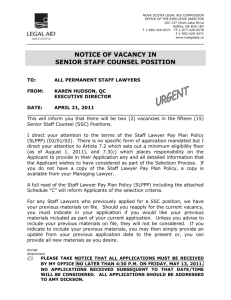November 2014
advertisement
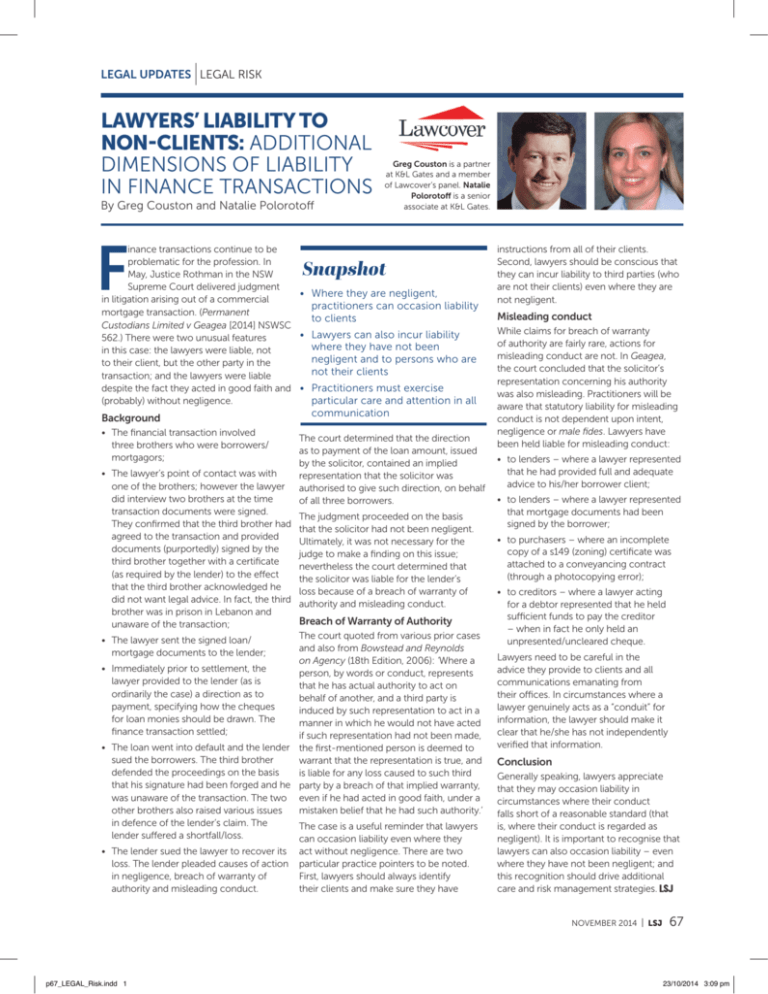
LEGAL UPDATES LEGAL RISK LAWYERS’ LIABILITY TO NON-CLIENTS: ADDITIONAL DIMENSIONS OF LIABILITY IN FINANCE TRANSACTIONS By Greg Couston and Natalie Polorotoff F Greg Couston is a partner at K&L Gates and a member of Lawcover’s panel. Natalie Polorotoff is a senior associate at K&L Gates. inance transactions continue to be problematic for the profession. In May, Justice Rothman in the NSW Supreme Court delivered judgment • Where they are negligent, in litigation arising out of a commercial practitioners can occasion liability mortgage transaction. (Permanent to clients Custodians Limited v Geagea [2014] NSWSC • Lawyers can also incur liability 562.) There were two unusual features where they have not been in this case: the lawyers were liable, not negligent and to persons who are to their client, but the other party in the not their clients transaction; and the lawyers were liable despite the fact they acted in good faith and • Practitioners must exercise (probably) without negligence. particular care and attention in all Background • The financial transaction involved three brothers who were borrowers/ mortgagors; • The lawyer’s point of contact was with one of the brothers; however the lawyer did interview two brothers at the time transaction documents were signed. They confirmed that the third brother had agreed to the transaction and provided documents (purportedly) signed by the third brother together with a certificate (as required by the lender) to the effect that the third brother acknowledged he did not want legal advice. In fact, the third brother was in prison in Lebanon and unaware of the transaction; Snapshot communication The court determined that the direction as to payment of the loan amount, issued by the solicitor, contained an implied representation that the solicitor was authorised to give such direction, on behalf of all three borrowers. The judgment proceeded on the basis that the solicitor had not been negligent. Ultimately, it was not necessary for the judge to make a finding on this issue; nevertheless the court determined that the solicitor was liable for the lender’s loss because of a breach of warranty of authority and misleading conduct. Breach of Warranty of Authority The court quoted from various prior cases and also from Bowstead and Reynolds on Agency (18th Edition, 2006): ‘Where a • Immediately prior to settlement, the person, by words or conduct, represents lawyer provided to the lender (as is that he has actual authority to act on ordinarily the case) a direction as to behalf of another, and a third party is payment, specifying how the cheques induced by such representation to act in a for loan monies should be drawn. The manner in which he would not have acted finance transaction settled; if such representation had not been made, • The loan went into default and the lender the first-mentioned person is deemed to sued the borrowers. The third brother warrant that the representation is true, and defended the proceedings on the basis is liable for any loss caused to such third that his signature had been forged and he party by a breach of that implied warranty, was unaware of the transaction. The two even if he had acted in good faith, under a other brothers also raised various issues mistaken belief that he had such authority.’ in defence of the lender’s claim. The The case is a useful reminder that lawyers lender suffered a shortfall/loss. can occasion liability even where they • The lawyer sent the signed loan/ mortgage documents to the lender; • The lender sued the lawyer to recover its loss. The lender pleaded causes of action in negligence, breach of warranty of authority and misleading conduct. act without negligence. There are two particular practice pointers to be noted. First, lawyers should always identify their clients and make sure they have instructions from all of their clients. Second, lawyers should be conscious that they can incur liability to third parties (who are not their clients) even where they are not negligent. Misleading conduct While claims for breach of warranty of authority are fairly rare, actions for misleading conduct are not. In Geagea, the court concluded that the solicitor’s representation concerning his authority was also misleading. Practitioners will be aware that statutory liability for misleading conduct is not dependent upon intent, negligence or male fides. Lawyers have been held liable for misleading conduct: • to lenders – where a lawyer represented that he had provided full and adequate advice to his/her borrower client; • to lenders – where a lawyer represented that mortgage documents had been signed by the borrower; • to purchasers – where an incomplete copy of a s149 (zoning) certificate was attached to a conveyancing contract (through a photocopying error); • to creditors – where a lawyer acting for a debtor represented that he held sufficient funds to pay the creditor – when in fact he only held an unpresented/uncleared cheque. Lawyers need to be careful in the advice they provide to clients and all communications emanating from their offices. In circumstances where a lawyer genuinely acts as a “conduit” for information, the lawyer should make it clear that he/she has not independently verified that information. Conclusion Generally speaking, lawyers appreciate that they may occasion liability in circumstances where their conduct falls short of a reasonable standard (that is, where their conduct is regarded as negligent). It is important to recognise that lawyers can also occasion liability – even where they have not been negligent; and this recognition should drive additional care and risk management strategies. NOVEMBER 2014 p67_LEGAL_Risk.indd 1 I LSJ 67 23/10/2014 3:09 pm

